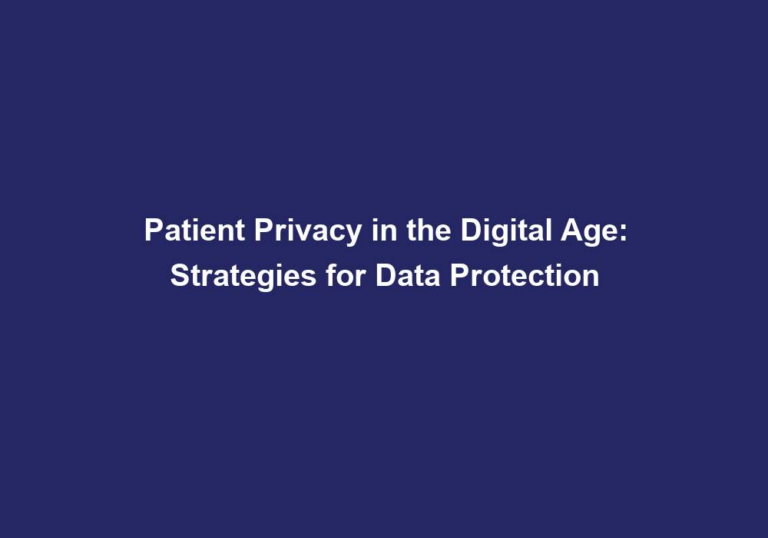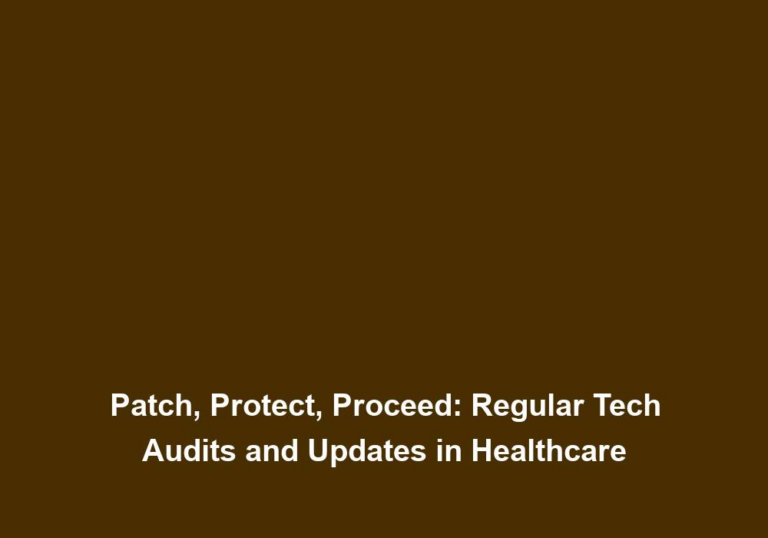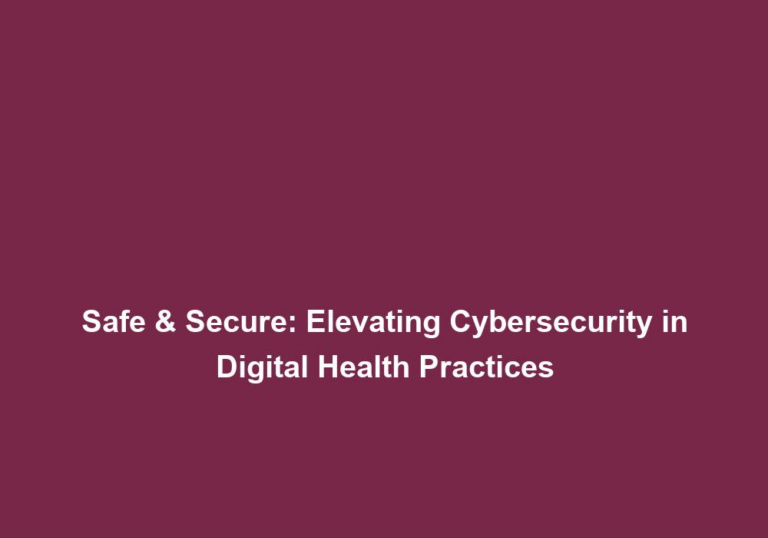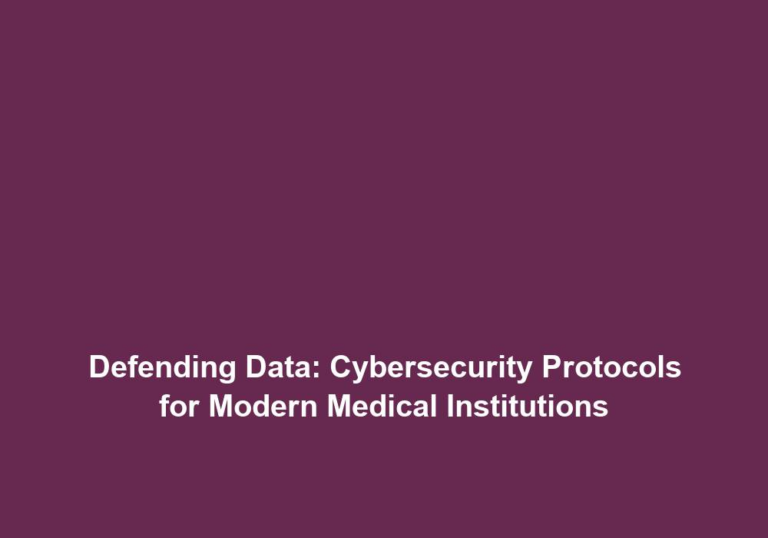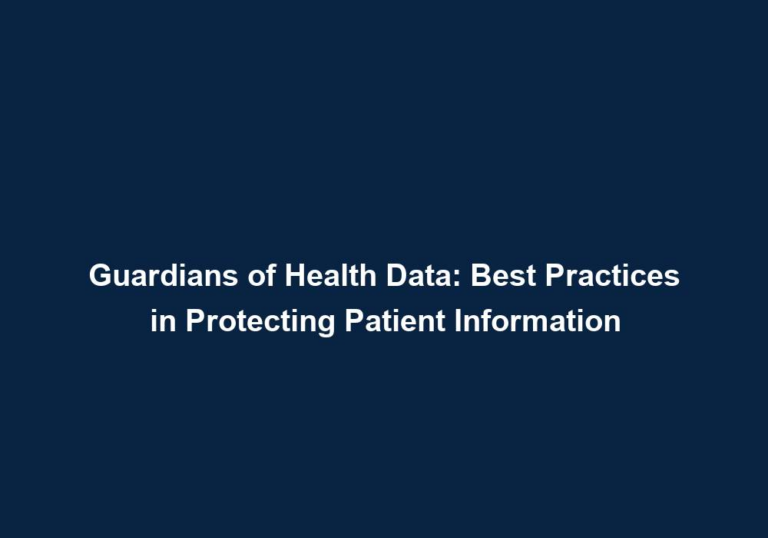The Digital Fortress: Safeguarding Patient Data in Healthcare
In the digital era, the healthcare industry is increasingly relying on technology to streamline operations and improve patient care. Electronic Health Records (EHRs), telemedicine, and other digital solutions have revolutionized the way healthcare providers deliver services. However, with the increased use of technology comes the need to safeguard sensitive patient data from cyber threats and ensure privacy. In this article, we will explore the importance of protecting patient data in healthcare and discuss various strategies and best practices to create a digital fortress for safeguarding patient information.
Understanding the Value of Patient Data
Patient data is a goldmine of information for hackers and cybercriminals. It includes personal and medical information, such as names, addresses, social security numbers, medical history, and even financial data. This treasure trove of data can be used for identity theft, insurance fraud, or sold on the dark web for a substantial profit. Therefore, it is crucial for healthcare organizations to recognize the value of patient data and take proactive steps to protect it.
To better understand the value of patient data, healthcare organizations should consider the following:
-
Identity Theft: Hackers can use patient data to create false identities and commit identity theft. They can open new credit accounts, apply for loans, or even file fraudulent tax returns using stolen information.
-
Insurance Fraud: Patient data can be exploited to commit insurance fraud. Fraudsters can use stolen information to submit false claims, resulting in financial losses for both the healthcare provider and the patient.
-
Financial Exploitation: Patient data often includes financial information, such as credit card details and bank account numbers. This data can be used to make unauthorized transactions or drain the victim’s bank account.
-
Black Market Profits: The dark web is filled with marketplaces where stolen patient data is bought and sold. Cybercriminals can profit from selling this information to other malicious actors, leading to potential harm for the individuals whose data is compromised.
To safeguard patient data effectively, healthcare organizations need to understand the potential risks and consequences associated with data breaches.
Compliance with HIPAA and Other Regulations
The Health Insurance Portability and Accountability Act (HIPAA) sets the standard for protecting sensitive patient data in the United States. It requires healthcare organizations to implement physical, technical, and administrative safeguards to ensure the confidentiality, integrity, and availability of patient information. Compliance with HIPAA is not only a legal requirement but also essential for maintaining patient trust and reputation.
Some key measures for HIPAA compliance include:
-
Conducting Regular Risk Assessments: Regular risk assessments help identify potential vulnerabilities in the security infrastructure. By understanding the risks and implementing appropriate controls, healthcare organizations can mitigate the chance of data breaches.
-
Implementing Access Controls: Access controls limit access to sensitive data to authorized personnel only. This ensures that patient data is accessed only by those with a legitimate need to do so, reducing the risk of unauthorized disclosure.
-
Data Encryption: Encrypting data in transit and at rest is crucial to prevent unauthorized access. Encryption ensures that even if data is intercepted or stolen, it remains unreadable and unusable to unauthorized individuals.
-
Employee Training: Training employees on security awareness and best practices for handling patient data is essential. Employees should be educated on topics such as password hygiene, phishing awareness, and secure remote working to minimize the risk of human error leading to data breaches.
-
Regular Auditing and Monitoring: Regularly auditing and monitoring systems helps detect any suspicious activities. By promptly identifying and investigating potential security incidents, healthcare organizations can minimize the impact of data breaches.
Apart from HIPAA, healthcare organizations should also stay updated on other relevant regulations and standards specific to their region or country to ensure comprehensive data protection.
Implementing Robust Security Measures
To create a digital fortress for patient data, healthcare organizations must employ robust security measures. This includes a combination of technical solutions, policies, and procedures to safeguard sensitive information. Here are some key strategies to consider:
1. Secure Network Infrastructure
Building a strong foundation starts with securing the network infrastructure. Healthcare organizations should implement firewalls, intrusion detection systems, and regular network monitoring to identify and respond to any potential threats. Conducting regular vulnerability assessments and penetration testing can also help identify weaknesses in the network and address them promptly.
2. Multi-factor Authentication (MFA)
Implementing MFA adds an extra layer of security to user accounts and helps prevent unauthorized access. By requiring users to verify their identity through multiple factors such as passwords, biometrics, or security tokens, healthcare organizations can significantly reduce the risk of data breaches caused by compromised credentials.
3. Data Encryption
Data encryption ensures that even if unauthorized individuals gain access to the data, it remains unreadable and unusable. Implementing end-to-end encryption for data in transit and at rest helps protect patient information from unauthorized access and provides an additional layer of security.
4. Regular Data Backups
Regularly backing up critical patient data is crucial to ensure its availability in the event of system failures, natural disasters, or cyber attacks. Implementing a robust backup strategy that includes off-site storage and frequent testing of the restoration process helps healthcare organizations recover data quickly and minimize downtime.
5. Employee Education and Training
Human error is often a significant factor in data breaches. Educating employees about the importance of data security and providing regular training on best practices can help prevent common mistakes and promote a culture of security awareness within the organization. Training programs should cover topics such as phishing awareness, password hygiene, and secure remote working.
6. Incident Response and Business Continuity Plans
Despite the best preventive measures, data breaches can still occur. Having a well-defined incident response plan and business continuity plan in place helps healthcare organizations respond swiftly to a breach, minimize its impact, and restore normal operations promptly. Regular testing and updating of these plans are essential to ensure their effectiveness.
Staying Ahead of Emerging Threats
The landscape of cybersecurity is constantly evolving, and healthcare organizations must stay ahead of emerging threats and vulnerabilities. This requires continuous monitoring of the security landscape, staying updated on the latest security patches and updates, and implementing proactive measures to address potential risks. Collaborating with cybersecurity experts and participating in information-sharing forums can also provide valuable insights into emerging threats and mitigation strategies.
Conclusion
Protecting patient data is a critical responsibility for healthcare organizations. By implementing robust security measures, complying with regulations like HIPAA, and staying vigilant against emerging threats, healthcare providers can create a digital fortress for safeguarding patient information. Investing in cybersecurity not only protects patients’ privacy but also helps maintain trust and ensure the overall well-being of the healthcare ecosystem.


